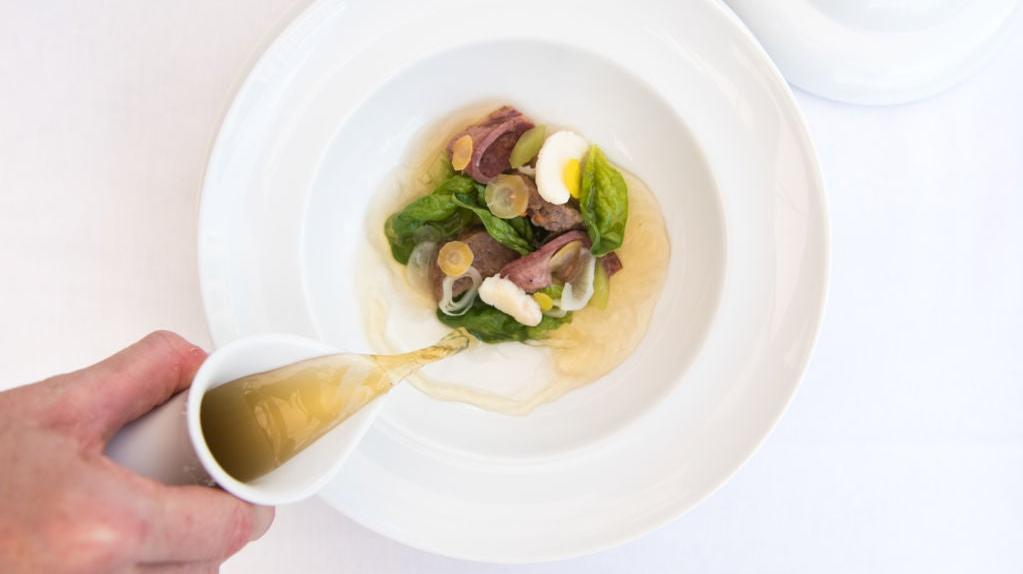Everyone Should Be Making Consommé
Sometimes, dishes become associated with haute cuisine for a good reason: because they’re delicious.
Consommé is defined quite simply as a clear soup made with concentrated stock, but the French word comes loaded with perceived meaning. Consommé comes from the latin consummate, which means "to complete, finish, or perfect." As if to say that any soup besides consommé is rather imperfect. It aims for straight-up flawlessness, turning a rustic, cloudy stock crystal-clear through the use of a "raft" (more on that later) to rid the stock of any impurities. That word, by the way, impurity, is also said a lot when talking about consommé, just one more way to emphasize perfectionism and vanity—no room for murky, inferior stocks here. Consommé is synonymous with gourmet, technique-driven French cooking and fine dining, which means that the average person might consider it unapproachable. Myself included.
For years, I avoided making a consommé. I would be content with my gloomy, overcast, rich-in-spirit country chicken stock, figuring that I didn't need to make an ultra-refined stock at home because I wasn't serving the Governor of California and his tennis instructor at the French Laundry. No, in my mind, consommé was decidedly not something one just "whips up" at home. It is not a working man's soup; it's the cosmopolitan slurp of society's elite. The loud day traders throwing down heavy credit cards to pay for expensive dinners, delusional country club members, that whole crowd. Therefore, I railed against consommé and all it stood for—at least until I actually made one.
When people describe consommé they'll try to sell you on it by talking up how crystal-clear it is, how perfect. Forget all that. Because the real enjoyment of consommé isn't its appearance, but its flavor. The intense, layered flavor of consommé is a miracle. It has all the taste of a rich stock or bone broth, but it's also fresh, clean, and nuanced. The word people should be using when they talk about consommé is depth. All the talk about consommé revolves around achieving immaculateness. I was baffled that nobody had explained to me that consommé will actually taste better than my regular stock. Shouldn't this have been the winning argument all along?
Consommé is made with a "raft," or a mix of blended egg whites, raw meat, and vegetables. The protein in the raft serves as an ultra-fine filter to clarify the stock. As the raft cooks and floats to the top, it injects a layer of freshness to your soup; rafts vary depending on what you've got simmering in your pot. For example, a beef consommé can call for raw ground beef, which lends a less concentrated, almost crisp flavor to your soup, along with aromatics that come through just as well. Whatever you decide to include in your raft—tomato, mushroom, shallot, etc.—it will all add those subtle and fresh notes to the consommé. Check out the demonstration of this recipe, by chef Daniel Boulud:
"I think consommé is the highest sophistication of a stock," Boulud says. Again, the word choice here is somewhat elitist. Sophisticated? I don't know. We're really just talking about soup with extra steps. But I love what Boulud says about it at the end of the video:
"I think consommé will never go away. It doesn't matter where you are from, what cuisine you make, what culture you belong to. As a chef, you will learn to make a consommé, and you will adapt consommé to your taste, to your country, to your cuisine. But, you never forget how to make a good consommé to begin with."
It's easy to sneer at French cuisine, all the way up on its gilded pedestal. French technique, for better or worse, is drilled into American culinary school students. Foie gras, tournée cuts, soufflés, flambéing, delicate poaching, rich beurre blancs, temperamental hollandaise. But for all these finicky dishes, there's a lot of heart and soul in French cooking, too. It is, after all, the home of potatoes gratin, cassoulet, the croque monsieur, and deliciously simple chocolate mousse. French cooking exists along a spectrum, like anything, and there's a lot to celebrate on the "low" end of that spectrum. That's why consommé is beautiful: because it floats somewhere in between the Parisian gourmet and the rustic countryside. There's technique involved, yes, but in the end... it's just soup. And if home cooks approach it the same way Boulud does, then it's soup that's clearly made with love.
My brother, a chef, recently found out I had never made consommé. "You haven't made one?" he asked. "You should do it just to do it." Not exactly a ringing endorsement, but that's exactly what made me interested in trying. It was a casual suggestion, a "why not?" sort of approach. We need to stop thinking about French cuisine as this rigorous, professional style of cooking and start thinking about all the ways it is a practical and, most importantly, delicious way of approaching food. Consommé tastes great, and we should all want to make things that taste great. We should all try everything once just to say we did it. Except maybe cocaine.
